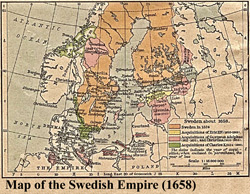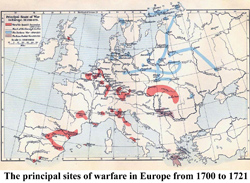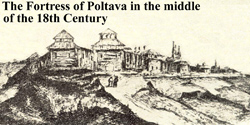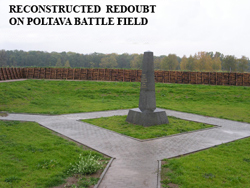 History
History
 Dates and events
Dates and events
 Persons
Persons
 Poltava
Poltava
 Sights
Sights
 Photo gallery
Photo gallery
 Maps
Maps
 Virtual Museum
Virtual Museum
 Armament
Armament
 Uniforms
Uniforms
 Coins and medals
Coins and medals
 Flags
Flags
 Paintings
Paintings
 Poltava photographs
Poltava photographs
 News
News
 About us
About us
 Acknowledgments
Acknowledgments
 Main page
Main page
The Great Northern War
 The Great Northern War was one of the most important
military and political events of the eighteenth century.
It determined not only the future destiny of Ukraine
but of Northern Europe as a whole. The extremely
aggressive foreign policy of
Charles's XII
predecessors, particularly that of his grandfather
Charles X Gustav
, contributed to the transition of Sweden into a mighty empire,
which controlled the majority of the countries bordering the Baltic
Sea. The main objectives of
Charles XI
, the father of Charles XII, were the strengthening of the
absolute monarchy and the development of Sweden’s economy.
At the same time Sweden’s unceasingly aggressive foreign policy
caused resentment and discontent in many European countries.
Russia also suffered from the aggressive policy of its northern neighbor,
having been forced to sign a peace treaty in 1617 that deprived it of
any outlet to the Baltic Sea, the main European trade route. After
Peter I
ascended to the throne, the return of Russia’s former possessions
along the Baltic became one of the
most important goals of his foreign policy. In 1699/1700 Russia
entered into an anti-Swedish alliance with Poland-Saxony and
Denmark. In August 1700, soon after signing a
peace treaty with Turkey, Russia declared war on Sweden.
At the same time, King Augustus II laid siege to the fortress
of Riga. The Great Northern war that was to last 21 years had started.
The Great Northern War was one of the most important
military and political events of the eighteenth century.
It determined not only the future destiny of Ukraine
but of Northern Europe as a whole. The extremely
aggressive foreign policy of
Charles's XII
predecessors, particularly that of his grandfather
Charles X Gustav
, contributed to the transition of Sweden into a mighty empire,
which controlled the majority of the countries bordering the Baltic
Sea. The main objectives of
Charles XI
, the father of Charles XII, were the strengthening of the
absolute monarchy and the development of Sweden’s economy.
At the same time Sweden’s unceasingly aggressive foreign policy
caused resentment and discontent in many European countries.
Russia also suffered from the aggressive policy of its northern neighbor,
having been forced to sign a peace treaty in 1617 that deprived it of
any outlet to the Baltic Sea, the main European trade route. After
Peter I
ascended to the throne, the return of Russia’s former possessions
along the Baltic became one of the
most important goals of his foreign policy. In 1699/1700 Russia
entered into an anti-Swedish alliance with Poland-Saxony and
Denmark. In August 1700, soon after signing a
peace treaty with Turkey, Russia declared war on Sweden.
At the same time, King Augustus II laid siege to the fortress
of Riga. The Great Northern war that was to last 21 years had started.
 King Charles XII proved to be a worthy successor to the Swedish
warrior kings in spite of his youth (he was only eighteen when the
war started in 1700). He was a gifted military strategist and an
inspiring and gifted leader. His goal was to defeat his enemies -
one by one. His first target was Denmark. After leading a surprise
attack on the City of Copenhagen and other Danish strongholds,
he forced king
Frederik IV of Denmark
to sign a peace treaty with Sweden, leave the Russian-Polish
alliance, and pay substantial retribution. After the defeat of Denmark,
Charles XII moved his army to
Riga
, overcame the enemy's siege of the city, and then defeated
the Russian army in the first major battle of the Northern
War, the Battle of
Narva
, on November 19, 1700
(map of the battle).
However, following these victories the
Swedish King
made a mistake when he refused to pursue the weakened
Russian army, and instead, spent seven years fighting against
the armies of Poland-Saxony under the command of
Augustus II.
This allowed the Russian Tsar to reorganize and modernize
his army and bring it up to European standards. When Charles
XII succeeded at last in defeating Poland-Saxony, and forced
Augustus II, the Polish king, to abdicate in favor of
Stanislaw Leszczinsky,
leave the alliance and sign the treaty of
Altranstadt,
the army of Peter I had been turned into a powerful fighting force.
The Russian victories in 1704 in the battles of
Narva
and Dorpat made it clear that Russia would be a formidable
adversary. However, Charles XII continued to push into the
Russian territories. In the summer of 1708 the Swedish army
was in desperate need of supplies and ammunition. A detachment
under the command of
General Lewenhaupt
had been ordered to deliver the much needed supplies from Riga.
Expecting the supplies to arrive, Charles crossed the Berezina River
with his army and started to move toward Moscow. However,
Lewenhaupt’s detachment was defeated by the Russians in the Battle of
Lesnaya,
and the entire pack train was lost. Instead of delivering supplies to
the hungry army, Lewenhaupt ended up delivering 6,000 equally hungry
survivors of the attack. Charles’ only option was to turn south toward
Ukraine and try to secure provisions from that area.
When the war between Russia and Sweden became more intense, the
Kozak Hetman Ivan Mazepa
had sought to secure Ukraine’s safety. He had hoped that Russia and
Sweden would fight their final battle somewhere outside Ukraine, but
when the Swedish ally Stanislaw Leszczinsky began to threaten Ukraine,
Mazepa asked Peter I for military
protection. Preparing for his own inevitable battle with Sweden,
the Russian tsar refused to become involved in Ukraine’s fight and,
therefore, rejected Mazepa’s request.
This was the last straw for Mazepa. The hetman regarded Peter’s
refusal to assist as a breach of the Russian-Ukrainian Treaty of
1654 and, as a result, considered Ukraine to be free to act in its
own best interest. In October 1708 Mazepa allied himself with
the Swedish king, Charles XII, and entered into a military and
political treaty with Sweden. About 3000 Kozaks followed him.
In accordance with the treaty, Sweden pledged military support
and agreed not to sign any treaty with Russia until Ukraine had
been fully liberated and its rights restored. Tsar Peter’s reaction
to Mazepa’s decision to join the Swedes was quick and cruel.
Prince Menshikov
, one of Peter’s commanders, destroyed Baturin, the Hetman’s capital,
and massacred all inhabitants. This event forced many of Mazepa’s
potential supporters to reconsider and once again change their
allegiance. After an extremely severe and exhausting winter the
Swedish army reached Poltava in the beginning of April 1709.
Here the decisive battle of the Great Northern War took
place on June 27, 1709. The Swedish army suffered a crushing
defeat and lost about 6900 dead and wounded.
The rest of the Swedish army, under the command of
General Lewenhaupt, capitulated on June 30, 1709 near
Perevolochna, and about 16000 Swedes were taken prisoner.
The King and Hetman Mazepa managed to escape with a
small detachment and took refuge in Moldavia, a country
ruled at that time by Turkish sultan
Ahmed III.
However, the King’s flight did not end the war. It continued for
another nine years. In the later years of the war, the battle
moved to the Baltic. Russia’s fleet dominated its Swedish
counterpart and added to Sweden’s total defeat.
On August 30, 1721, Russia and Sweden signed the
Treaty of Nystad.
Russia gained Livonia, Estonia, Ingermanland, and part of Karelia.
The Great Northern War ended Sweden’s position as the dominant
power in Northern Europe and the Baltic Sea. This position was
now taken over by Russia. As for Ukraine, the Great Northern
War eliminated all hopes for independence. After the defeat of
Sweden, the final absorption of the Kozak state into the mighty
Russian empire was simply a matter of time.
King Charles XII proved to be a worthy successor to the Swedish
warrior kings in spite of his youth (he was only eighteen when the
war started in 1700). He was a gifted military strategist and an
inspiring and gifted leader. His goal was to defeat his enemies -
one by one. His first target was Denmark. After leading a surprise
attack on the City of Copenhagen and other Danish strongholds,
he forced king
Frederik IV of Denmark
to sign a peace treaty with Sweden, leave the Russian-Polish
alliance, and pay substantial retribution. After the defeat of Denmark,
Charles XII moved his army to
Riga
, overcame the enemy's siege of the city, and then defeated
the Russian army in the first major battle of the Northern
War, the Battle of
Narva
, on November 19, 1700
(map of the battle).
However, following these victories the
Swedish King
made a mistake when he refused to pursue the weakened
Russian army, and instead, spent seven years fighting against
the armies of Poland-Saxony under the command of
Augustus II.
This allowed the Russian Tsar to reorganize and modernize
his army and bring it up to European standards. When Charles
XII succeeded at last in defeating Poland-Saxony, and forced
Augustus II, the Polish king, to abdicate in favor of
Stanislaw Leszczinsky,
leave the alliance and sign the treaty of
Altranstadt,
the army of Peter I had been turned into a powerful fighting force.
The Russian victories in 1704 in the battles of
Narva
and Dorpat made it clear that Russia would be a formidable
adversary. However, Charles XII continued to push into the
Russian territories. In the summer of 1708 the Swedish army
was in desperate need of supplies and ammunition. A detachment
under the command of
General Lewenhaupt
had been ordered to deliver the much needed supplies from Riga.
Expecting the supplies to arrive, Charles crossed the Berezina River
with his army and started to move toward Moscow. However,
Lewenhaupt’s detachment was defeated by the Russians in the Battle of
Lesnaya,
and the entire pack train was lost. Instead of delivering supplies to
the hungry army, Lewenhaupt ended up delivering 6,000 equally hungry
survivors of the attack. Charles’ only option was to turn south toward
Ukraine and try to secure provisions from that area.
When the war between Russia and Sweden became more intense, the
Kozak Hetman Ivan Mazepa
had sought to secure Ukraine’s safety. He had hoped that Russia and
Sweden would fight their final battle somewhere outside Ukraine, but
when the Swedish ally Stanislaw Leszczinsky began to threaten Ukraine,
Mazepa asked Peter I for military
protection. Preparing for his own inevitable battle with Sweden,
the Russian tsar refused to become involved in Ukraine’s fight and,
therefore, rejected Mazepa’s request.
This was the last straw for Mazepa. The hetman regarded Peter’s
refusal to assist as a breach of the Russian-Ukrainian Treaty of
1654 and, as a result, considered Ukraine to be free to act in its
own best interest. In October 1708 Mazepa allied himself with
the Swedish king, Charles XII, and entered into a military and
political treaty with Sweden. About 3000 Kozaks followed him.
In accordance with the treaty, Sweden pledged military support
and agreed not to sign any treaty with Russia until Ukraine had
been fully liberated and its rights restored. Tsar Peter’s reaction
to Mazepa’s decision to join the Swedes was quick and cruel.
Prince Menshikov
, one of Peter’s commanders, destroyed Baturin, the Hetman’s capital,
and massacred all inhabitants. This event forced many of Mazepa’s
potential supporters to reconsider and once again change their
allegiance. After an extremely severe and exhausting winter the
Swedish army reached Poltava in the beginning of April 1709.
Here the decisive battle of the Great Northern War took
place on June 27, 1709. The Swedish army suffered a crushing
defeat and lost about 6900 dead and wounded.
The rest of the Swedish army, under the command of
General Lewenhaupt, capitulated on June 30, 1709 near
Perevolochna, and about 16000 Swedes were taken prisoner.
The King and Hetman Mazepa managed to escape with a
small detachment and took refuge in Moldavia, a country
ruled at that time by Turkish sultan
Ahmed III.
However, the King’s flight did not end the war. It continued for
another nine years. In the later years of the war, the battle
moved to the Baltic. Russia’s fleet dominated its Swedish
counterpart and added to Sweden’s total defeat.
On August 30, 1721, Russia and Sweden signed the
Treaty of Nystad.
Russia gained Livonia, Estonia, Ingermanland, and part of Karelia.
The Great Northern War ended Sweden’s position as the dominant
power in Northern Europe and the Baltic Sea. This position was
now taken over by Russia. As for Ukraine, the Great Northern
War eliminated all hopes for independence. After the defeat of
Sweden, the final absorption of the Kozak state into the mighty
Russian empire was simply a matter of time.
The Battle of Poltava
Because of the harsh winter of 1708/09 and a series of military
defeats, the situation of the Swedish army in Ukraine had become
precarious. In late April 1709 Charles XII decided to lay siege to
the fortress of Poltava.
 Although the Swedish army consisted of about 31,000 men at the
time, the king decided to engage only 4 cannons and
about 6,000 of his soldiers in the siege. The Swedish army cut off
all access to the city, including any possible approaches by the
Russians across the Vorskla River.
In contrast, the Russian Tsar commanded 49,000 men and about
130 cannons. Thus, the Russians had a substantial numerical
advantage on the eve of the battle.
When Tsar Peter I arrived from the fortress of Azov to join his
army on June 5th, he decided to move the army to the western
bank of the Vorskla. On June 20th all Russian
units crossed the Vorskla near the villages of Petrovka and
Semyonovka. The army then moved south and set up a
fortified camp
near the village of Yakivtsy. In front of the camp was a one-kilometer
wide open field of dry, sandy soil, bordered by the Budyschenski
Forest. A hundred meters south of the fortified camp lay the
Yakovetski Forest, an area of woodland, streams and gullies.
Although the Swedish army consisted of about 31,000 men at the
time, the king decided to engage only 4 cannons and
about 6,000 of his soldiers in the siege. The Swedish army cut off
all access to the city, including any possible approaches by the
Russians across the Vorskla River.
In contrast, the Russian Tsar commanded 49,000 men and about
130 cannons. Thus, the Russians had a substantial numerical
advantage on the eve of the battle.
When Tsar Peter I arrived from the fortress of Azov to join his
army on June 5th, he decided to move the army to the western
bank of the Vorskla. On June 20th all Russian
units crossed the Vorskla near the villages of Petrovka and
Semyonovka. The army then moved south and set up a
fortified camp
near the village of Yakivtsy. In front of the camp was a one-kilometer
wide open field of dry, sandy soil, bordered by the Budyschenski
Forest. A hundred meters south of the fortified camp lay the
Yakovetski Forest, an area of woodland, streams and gullies.
 In the area between the two forests the Russians had built
10 redoubts to guard the approach to the camp. Each
redoubt consisted of a high parapet with a trench in front of it.
The redoubts were manned by 4,000 infantry men
(8 battalions) and 16 guns. On the eve of battle, disaster
struck the Swedes. Charles XII was wounded during a brief
encounter with the Russians while on reconnaissance.
This unfortunate incident
deprived the Swedes of their charismatic and able leader -
more than that, their talisman of victory. Although the King
retained nominal command of the army, he had to delegate
direct control to
Field Marshal Rehnskold.
The Swedish plan was simple. The army would assemble during
the night south of the Russian redoubts and move through the
redoubt line before dawn. The infantry troops under
the command of Lewenhaupt would be the first to move forward
through the redoubt line, followed by the cavalry.
The foot soldiers would then launch an attack on the Russians
crammed inside their fortified camp.
The 18 Swedish battalions were divided into four columns, supported
by a battery of four regimental guns. The Swedish infantry moved
into position soon after midnight.
Their starting lines were about a kilometer south of the first Russian
redoubt, from which the sound of sawing and hammering could be
heard. There they waited. When the
cavalry finally arrived after two hours dawn was already breaking.
By the time the whole Swedish army was assembled, the late start
put the element of surprise at risk. After
conferring with his two principal commanders, the King decided to
go forward with the attack anyway. The time was about 4.00 a.m.
The battle had begun.
In the area between the two forests the Russians had built
10 redoubts to guard the approach to the camp. Each
redoubt consisted of a high parapet with a trench in front of it.
The redoubts were manned by 4,000 infantry men
(8 battalions) and 16 guns. On the eve of battle, disaster
struck the Swedes. Charles XII was wounded during a brief
encounter with the Russians while on reconnaissance.
This unfortunate incident
deprived the Swedes of their charismatic and able leader -
more than that, their talisman of victory. Although the King
retained nominal command of the army, he had to delegate
direct control to
Field Marshal Rehnskold.
The Swedish plan was simple. The army would assemble during
the night south of the Russian redoubts and move through the
redoubt line before dawn. The infantry troops under
the command of Lewenhaupt would be the first to move forward
through the redoubt line, followed by the cavalry.
The foot soldiers would then launch an attack on the Russians
crammed inside their fortified camp.
The 18 Swedish battalions were divided into four columns, supported
by a battery of four regimental guns. The Swedish infantry moved
into position soon after midnight.
Their starting lines were about a kilometer south of the first Russian
redoubt, from which the sound of sawing and hammering could be
heard. There they waited. When the
cavalry finally arrived after two hours dawn was already breaking.
By the time the whole Swedish army was assembled, the late start
put the element of surprise at risk. After
conferring with his two principal commanders, the King decided to
go forward with the attack anyway. The time was about 4.00 a.m.
The battle had begun.
(see maps of the Battle of Poltava)
The battle started with the Swedes advancing boldly against the
Russian fortified lines. Two incomplete redoubts were taken
rapidly and all the defenders killed. However, the
Swedes’ initial success was quickly brought to an end.
All assaults on the third redoubt were repulsed and the dead
lay in heaps in the trench surrounding it.
The Russian dragoons retreated to the north, pursued by both
wings of the Swedish cavalry. General Lewenhaupt’s infantry
attempted to attack the Russians and even reached
the southern corner of their camp. But the Swedish advance
soon faltered, because both infantry and advancing cavalry
were ordered by Rehnskold to withdraw and reorganize.
To make matters worse, one Swedish detachment, commanded by
General Roos
, had not been informed about the overall strategy and, therefore,
became separated from the rest
of the Swedish troops. When a column of about 4,000 Russian
reinforcements reoccupied
the fortified positions, General Roos and his forces were trapped.
With over 1,000
casualties and ammunition running low, General Roos was forced
to withdraw southward
and later surrendered his command. As result of this lack of
communication among the
divisions, the Swedish army lost one third of its infantry before
the real battle had
even started.
The Swedes delayed further action while waiting for Roos to
return. Around 10 o’clock,
when the Russians infantry started to move out of its
fortified camp, the Swedes decided to
also move forward. Because of their numerical
superiority, the Russian front line was
400 to 500 meters wider than the Swedish one.
In addition the Swedish flanks were not
properly protected by the cavalry. When the
Swedish infantry had advanced to within
200 meters of the Russian defenders, the Russian
artillerymen switched to canister fire.
The effect of this was likened to “a hailstorm,”
mowing down entire lines of men.
While the right wing of the Swedish army was
pushed back by the Russian artillery,
the Russian cavalry outflanked the Swedes’ left wing.
The Swedish cavalry tried to buy the infantry time
to get away but failed. The soldiers of
Charles XII started to flee the field. The battle had
become a slaughter and it was not yet 11 o’clock.
Charles XII had no
choice but to gather the remainder of his troops
and retreat to the south,
thus abandoning the siege of Poltava. More than
6,900 Swedish soldiers
lost their lives on the battlefield that morning.
Another 2,800 were being taken prisoner.
Russian losses have been estimated at 1,345
killed and 3,200 wounded.
Some trophies taken by the Russians in the
Battle of Poltava, including cold steel, firearms, flags, drums and trumpets,
were later moved to the
Kremlin Armory.
 top top |
 ...back ...back |